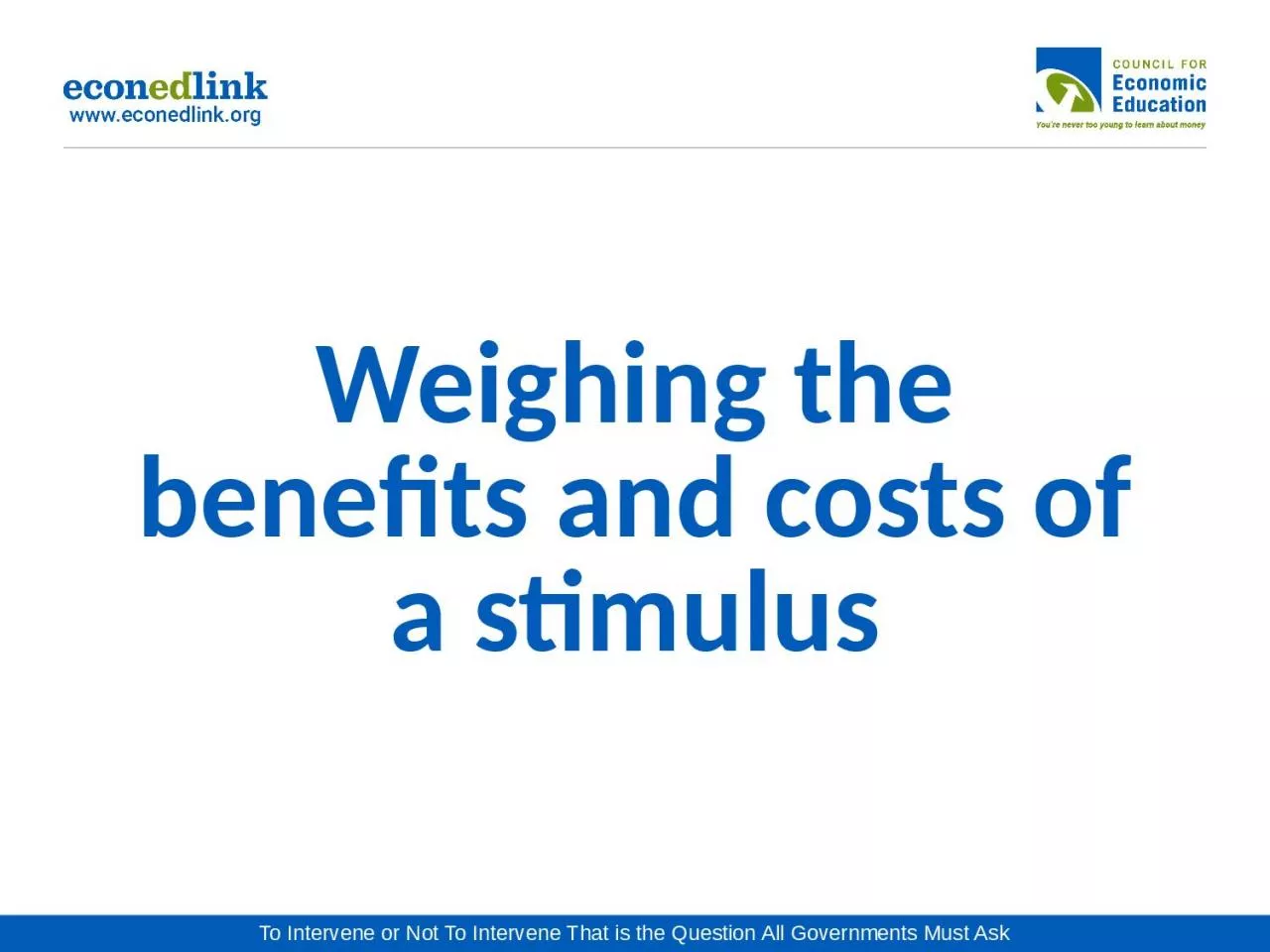

Concepts to know Debt vs Deficit Federal budget deficit measured typically over the course of one year a deficit occurs when the federal governments outlays payments are larger than its receipts funds paid to government ID: 1028494
Download Presentation The PPT/PDF document "Weighing the benefits and costs of a sti..." is the property of its rightful owner. Permission is granted to download and print the materials on this web site for personal, non-commercial use only, and to display it on your personal computer provided you do not modify the materials and that you retain all copyright notices contained in the materials. By downloading content from our website, you accept the terms of this agreement.
1. Weighing the benefits and costs of a stimulus
2. Concepts to know: Debt vs. DeficitFederal budget deficit – measured typically over the course of one year, a deficit occurs when the federal government’s outlays (payments) are larger than its receipts (funds paid to government).Implication: The U.S. must borrow to fund the deficit. The United States Treasury borrows the funds by selling U.S. Treasury Bills, Notes, and Bonds. The Treasury must pay interest on these securities.National debt – is the total amount owed by the United States government due to the accumulation of deficits over many years. Implication: Budget deficits increase the debt as more is owed. Budget surpluses decrease the debt as funds are repaid.
3. Concepts to know: Interest RateInterest rate – is the amount a borrower pays to the lender for a loan. The interest rate is expressed as a percentage of the amount owed.
4. Concepts to know: As Percentage of GDPPersonal Consumption Expenditures Since 1960Personal Consumption Expenditures as a Percentage of GDP Since 1960
5. Concepts to knowPersonal Consumption Expenditures (Durables) Since 1960Will generally increase because of:Inflation (when expressed in dollars)Growth in the economyLooking at this graph does not tell very much.Personal Consumption Expenditures as a Percentage of GDP Since 1960Is not sensitive to inflation. By dividing by GDP, the statistic shows how big something is relative to the economy size.
6. Event to know: CARES ActEnacted March 27, 2020Included (only parts of the entire law):Cash payment to individualsFederal Pandemic Unemployment Compensation increases unemployment paymentsPaycheck Protection Program for small businesses to take loans that may be forgiven if the business retains its employeesHelp for large businesses like the airlinesAid for state and local governmentsAid to hospitals
7. GoalsWhat are the immediate benefits of an expansionary fiscal policy or fiscal stimulus during a recession like the COVID-19 recession?How large or important are these benefits?What are the long-run costs of an expansionary fiscal policy or fiscal stimulus during a recession like the COVID-19 recession?How large or important are these costs?Is a fiscal stimulus a useful tool to counteract the effects of the current Covid-19 recession?
8. Focus Groups and Task Groups
9. Focus Group QuestionsDoes the economy currently need more stimulus?Are households, businesses, and state and local governments stressed and in need of help?Based on historical levels and future projections, are high interest rates currently a concern?Based on current and historical measures, are interest payments currently a concern to the overall federal budget?Did the CARES Act expense have a big impact on the budget deficit and national debt?Does a one-time intervention such as the CARES Act have a continued effect on the long-term deficit or debt? What government programs are likely to contribute to increased deficits and federal debt in the future?
10. Final Question for Task Group First, each member of the task group will relay the main question posed to their focus group and discuss the focus group’s consensus.Second, after six focus questions have been discussed, the task group should discuss the final question:After weighing the immediate benefits of a stimulus against stimulus’ long-term costs, is a fiscal stimulus a useful tool to counteract the effects of the current Covid-19 recession?
11. BenefitsMoves economy towards potential GDP faster leading to a faster recovery of economic growthReduces unemploymentHelps reduce stress on householdsHelps small and large businesses recoverHelps local and state governments provide servicesStimulus?CostsIncreases national debtIncreases interest paid in future by federal governmentMay hinder business borrowing for investment if interest rates rise
12. Questions to ask about the long-term costs of a stimulus on the debtDo interest rates rise significantly to high levels because of the stimulus?Are interest payments historically large relative to GDP?What contributes to a rise in costs leading to a larger national debt?One-time money stimulus programsOngoing programsCan taxes be raised in the future to reduce the debt?
13. The Debate…https://www.marketwatch.com/story/ted-cruz-is-asked-why-national-debt-is-paramount-to-republicans-only-when-a-democrat-is-in-the-white-house-11603831170https://www.usnews.com/cartoons/deficit-and-budget-cartoons
14. Focus Group Questions (brief version):Does the economy currently need more stimulus?Are households and businesses stressed and in need of help?Based on historical levels, are high interest rates currently a concern?Based on current and historical measures, are interest payments currently a concern to the overall federal budget?Did the CARES Act expense have a big impact on the national debt?Does a one-time intervention such as the CARES Act have a continued effect on the long-term deficit or debt?